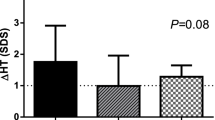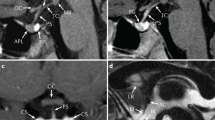Abstract
Gitelman disease was diagnosed in two unrelated children with hypokalemic metabolic alkalosis and growth failure (a boy and a girl aged 7 mo and 9.5 y, respectively, at clinical presentation) on the basis of mutations detected in the gene encoding the thiazide-sensitive NaCl cotransporter of the distal convoluted tubule. GH deficiency was demonstrated by specific diagnostic tests in both children. Hypertonic saline infusion tests showed a partial vasopressin deficiency in the girl and delayed secretion of this hormone in the boy. Magnetic resonance imaging revealed an empty sella in both cases. Up to now, hypomagnesemia and hypocalciuria have been considered obligatory criteria for the diagnosis of Gitelman disease; however, our two patients had hypomagnesia and hypocalciuria in less than half the determinations. GH replacement treatment was associated with a good clinical response in both children. It appears that these cases represent a new phenotype, not previously described in Gitelman disease, and that the entity may be considered a new complex hereditary renal tubular-pituitary syndrome.
Similar content being viewed by others
Log in or create a free account to read this content
Gain free access to this article, as well as selected content from this journal and more on nature.com
or
Abbreviations
- BSC:
-
bumetanide-sensitive Na-K-2Cl cotransporter
- CLCNKB:
-
chloride channel
- FE:
-
fractional excretion
- ROMK:
-
inwardly rectifying renal potassium channel
- SCCP:
-
single-strand conformation polymorphism analysis
- TSC:
-
thiazide-sensitive cotransporter
References
Gitelman HJ, Graham JB, Welt LG 1966 A new familial disorder characterized by hypokalemia and hypomagnesemia. Trans Assoc Am Physicians 79: 221–235
Simon DB, Nelson-Williams C, Johnson Bia M, Ellison D, Karet FE, Morey Molina A, Vaara I, Iwata F, Cusher HM, Koolen M, Gianza FJ, Gitelman HJ, Lifton RP 1996 Gitelman's variant of Bartter's syndrome, inherited hypokalaemic alkalosis, is caused by mutations in the thiazide-sensitive Na-Cl cotransporter. Nat Genet 12: 24–30
Mastroianni N, De Fusco M, Zollo M, Arrigo G, Zuffardi O, Bettinelli A, Ballabio A, Casari G 1996 Molecular cloning, expression pattern, and chromosomal localization of the human Na-Cl thiazide-sensitive cotransporter (SLC12A3). Genomics 35: 486–493
Rodriguez-Soriano J, Vallo A, Garcia-Fuentes M 1987 Hypomagnesemia of hereditary renal origin. Pediatr Nephrol 1: 465–472
Bettinelli A, Bianchetti MG, Girardin E, Caringella A, Cecconi M, Claris Appiani A, Pavanello R, Gastaldi R, Isimbaldi C, Lama G, Marchesoni C, Matteucci C, Patriarca C, Di Natale B, Setzu C, Vitucci P 1992 Use of calcium excretion values to distinguish two forms of primary renal tubular hypokalemic alkalosis: Bartter and Gitelman syndromes. J Pediatr 120: 38–43
Lemmink HH, Knoers N, Rarolyi L, van DijK H, Niaudet P, Antignac C, Guay-Woodford LM, Goodyer PR, Carel JC, Hermes A, Seyberth HW, Monnens LAH, van den Heudel LP 1998 Novel mutations in the thiazide-sensitive NaCl cotransporter gene in patients with Gitelman syndrome with predominant localization to the C-terminal domain. Kidney Int 54: 720–730
Ko CW, Koo JH 1997 Growth hormone (GH) deficiency may contribute to the occurrence of short stature in a child with Gitelman's syndrome. Am Soc Nephrol 7: 104A
Zerbe RL, Robertson GL 1981 A comparison of plasma vasopressin measurements with a standard indirect test in the differential diagnosis of polyuria. N Engl J Med 305: 1539–1546
Baylis PH, Thompson CJ 1988 Osmoregulation of vasopressin secretion and thirst in health and disease. Clin Endocrinol 29: 549–576
Colussi G, Rombolà G, Verde G, Airaghi C, Loli P, Minetti L 1992 Distal nephron function in Bartter's syndrome: abnormal conductance to chloride in the cortical collecting tubule?. Am J Nephrol 12: 229–239
Orita M, Suzuki Y, Sekiya T, Hayasmi K 1989 Rapid and sensitive detection of point mutations and DNA polymorphism using the polymerase chain reaction. Genomics 5: 874–879
Simon D, Karet F, Hamdan J, Di Pietro A, Sanjad S, Lifton R 1996 Bartter's syndrome, hypokalemic alkalosis with hypercalciuria, is caused by mutations in the Na-K-2Cl cotransporter NKCC2. Nat Genet 13: 183–188
Simon D, Bindra R, Mansfield T, Nelson-Williams C, Mendonca E, Stone R, Schurman S, Nayir A, Alpay H, Bakkaloglu A, Rodriguez-Soriano J, Morales JM, Sanjad SA, Taylor CM, Pilz D, Brem A, Trachtman H, Griswold W, Richard GA, John E, Lifton RP 1997 Mutations in the chloride channel gene, CLCNKB, cause Bartter syndrome type III. Nat Genet 17: 171–178
Simon D, Karet F, Rodriguez-Soriano J, Hamdan J, Di Pietro A, Trachtman H, Sanjad SA, Lifton RP 1996 Genetic heterogeneity of Bartter's syndrome revealed by mutations in the K+ channel, ROMK. Nat Genet 12: 152–156
Mastroianni N, Bettinelli A, Bianchetti MG, Colussi G, De Fusco M, Sereni F, Ballabio A, Casari C 1996 Novel molecular variants of the Na-Cl cotransporter gene are responsible for Gitelman syndrome. Am J Hum Genet 59: 1019–1026
Bettinelli A, Vezzoli G, Colussi G, Bianchetti MG, Sereni F, Casari G 1998 Genotype-phenotype correlations in normotensive patients with primary renal tubular hypokalemic metabolic alkalosis. J Nephrol 11: 61–70
Gill JR Jr 1992 Disorders of renal transport of sodium, potassium, magnesium, and calcium. In: Edelman CH (ed) Pediatric Kidney Disease. Little, Brown and Company, Boston, pp 1873–1887
Wright FC, Giebisch G 1978 Renal potassium transport: contribution of individual nephron segments and populations. Am J Physiol 235:F515–F525
Seyberth HW, Rascher W, Schweer H, Kuhl PG, Mehls O, Scharer K 1985 Congenital hypokalemia with hypercalciuria in preterm infants: a hyperprostaglandinuric tubular syndrome different from Bartter syndrome. J Pediatr 107: 694–701
Quamme GA 1997 Renal magnesium handling: new insights in understanding old problems. Kidney Int 52: 1180–1195
Colussi G, Macaluso M, Brunati C, Minetti L 1994 Calcium metabolism and calciotropic hormone levels in Gitelman's syndrome. Miner Electrolyte Metab 20: 294–301
Colussi G, Rombolà G, Brunati C, De Ferrari ME 1997 Abnormal reabsorption of Na+/Cl- by the thiazide-inhibitable transporter of the distal convoluted tubule in Gitelman's syndrome. Am J Nephrol 17: 103–111
Zucchini S, Ambrosetto P, Carla G, Tani G, Franzoni E, Cacciari E 1995 Primary empty sella: differences and similarities between children and adults. Acta Paediatr 84: 1362–1365
Dillon MJ, Shah V, Mitchell MD 1979 Bartter's syndrome: 10 cases in childhood. Q J Med 191: 429–446
Floret D, David M, Roux A, Hage GN, Teyssier G 1979 Syndrome de Bartter: effects à long terme de l'indométacine sur la croissance. Nouv Presse Med 8: 17–21
Clive DM, Stoff JS 1984 Renal syndromes associated with nonsteroidal antiinflammatory drugs. N Engl J Med 1984: 310:56563-572
Lindsley CB, Warady BA 1990 Nonsteroidal antiinflammatory drugs. Clin Pediatr 29: 10–13
Hené RJ, Koomans HA, Dorhout Mees EJ, Stolpe AVD, Verhoef GEG, Boer P 1987 Correction of hypokalemia in Bartter's syndrome by enalapril. Am J Kidney Dis 9: 200–205
Ruvalcaba RHA, Martinez FE 1992 Case report: familial growth hormone deficiency associated with Bartter's syndrome. Am J Med Sci 303: 411–414
Boer LA, Zoppi G 1992 Bartter's syndrome with impairment of growth hormone secretion. [letter] Lancet 340: 860
Flyvbjerg A, Dorup I, Everts ME, Orskov H 1991 Evidence that pottasium deficiency induces growth retardation through reduced circulating levels of growth hormone and insulin-like growth factor I. Metabolism 40: 769–775
Simopoulos AP, Bartter FC 1972 Growth characteristics and factor influencing growth in Bartter's syndrome. J Pediatr 81: 56–65
Simopoulos AP 1979 Growth characteristics in patients with Bartter's syndrome. Nephron 23: 130–135
Kaufman B 1969 The "empty" sella turcica-a manifestation of the intrasellar subarachnoid space. Radiology 90: 931–941
Ferreri AJ, Garrido SA, Markarian MG, Yanez A 1992 Relationship between the development of diaphragma sellae and the morphology of the sella turcica and its content. Surg Radiol Anat 14: 233–239
Marano GD, Horton JA, Vazaquez AM 1981 Computed tomography in diabetes insipidus: posterior empty sella. Br J Radiol 54: 263–265
Hung W, Fitz CR 1992 The primary empty-sella syndrome and diabetes insipidus in a child. Acta Paediatr 81: 459–461
Stahl MMS, Vaara I, Hedner P, Ekmans R 1993 Vasoactive peptides in Bartter's syndrome. Eur J Clin Invest 23: 80–83
Acknowledgements
The authors thank the Associazione per il Bambino Nefropatico, Telethon Institute of Genetics and Medicine of Milan (TIGEM), and Ms Melissa Smith for the assistance in preparation of this manuscript.
Author information
Authors and Affiliations
Rights and permissions
About this article
Cite this article
Bettinelli, A., Rusconi, R., Ciarmatori, S. et al. Gitelman Disease Associated with Growth Hormone Deficiency, Disturbances in Vasopressin Secretion and Empty Sella: A New Hereditary Renal Tubular-Pituitary Syndrome?. Pediatr Res 46, 232–238 (1999). https://doi.org/10.1203/00006450-199908000-00017
Received:
Accepted:
Issue date:
DOI: https://doi.org/10.1203/00006450-199908000-00017
This article is cited by
-
Classic Bartter syndrome complicated with profound growth hormone deficiency: a case report
Journal of Medical Case Reports (2013)
-
Longitudinal growth in chronic hypokalemic disorders
Pediatric Nephrology (2010)
-
A patient with Bartter syndrome accompanying severe growth hormone deficiency and focal segmental glomerulosclerosis
Clinical and Experimental Nephrology (2010)
-
Gitelman syndrome: when will it turn into Gitelman disease?
Pediatric Nephrology (2003)



